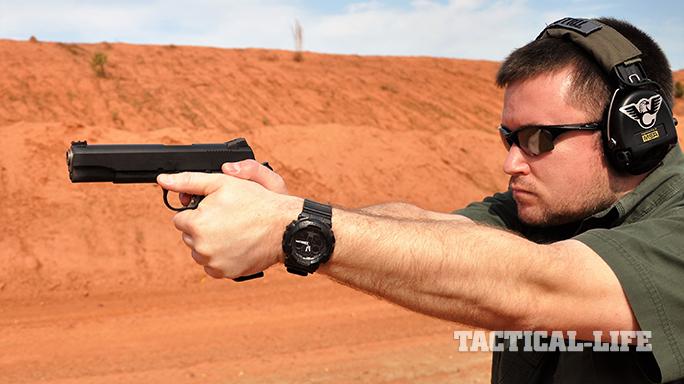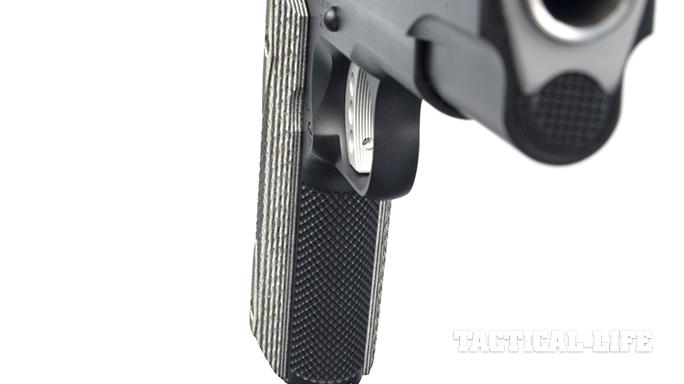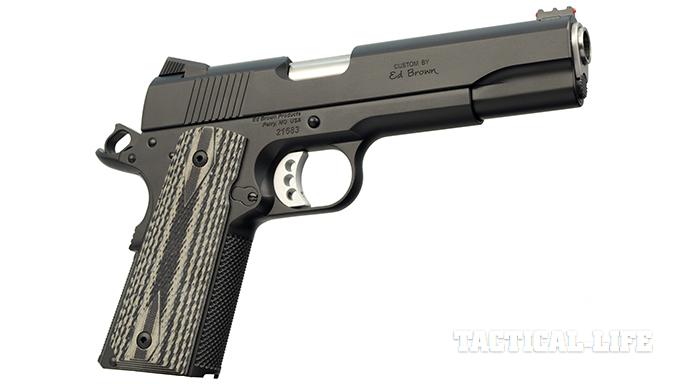The name Ed Brown has been synonymous with quality 1911 pistols and parts for over 50 years. Ed started working on pistols and competing in the new ISPC game in the 1970s. This led to him opening Ed Brown Products with the goal of producing the world’s best parts and pistols. While his parts are widely respected and used, Ed’s personal story is largely unknown. Part of that is because Ed is a private person who believes in letting his products sell themselves.
Over the years, Ed grew the business into a highly successful enterprise. This was done with very little advertising or marketing strategies. To many gunsmiths, Ed Brown parts became the standard by which others were measured. Some of the best gunsmiths in the world used Ed’s parts because of their quality and consistency. The secret to this was that Ed’s employees were machinists and engineers. They understood specifications and taking a part from an engineer’s drawing to production. Attention to detail, maintaining tolerances and efficiency were in their DNA.
The “Ed Brown Way” is the roadmap for the company’s success. These parts are “engineered for performance.” Every component and part is manufactured to exacting tolerances that can only be attained through engineer using computer-automated processes. This allows Brown to “improve” on parts that originally had a weak area. In fact, the company has over $15 million invested in its CNC capabilities to ensure vertical integration. This ensures that the company is not dependent on outside vendors for any critical components. The frames and slides are machined from forgings on multiple five-axis CNC machines. The hammers, sears, disconnects and other internal parts are CNC-machined from bar stock. To quote Travis Brown, “Our conformance is verified on a coordinate measuring machine that is so sophisticated, approval was necessary from the Department of Defense before it could be purchased and installed.”
Advertisement — Continue Reading Below
The company even has a Swiss screw machine to make grip screws in-house. However, it takes a lot of skill to assemble these parts into a pistol. That’s why every Ed Brown pistol is assembled by a master craftsman to ensure that each one meets the standards set by Ed.
Passing The Torch
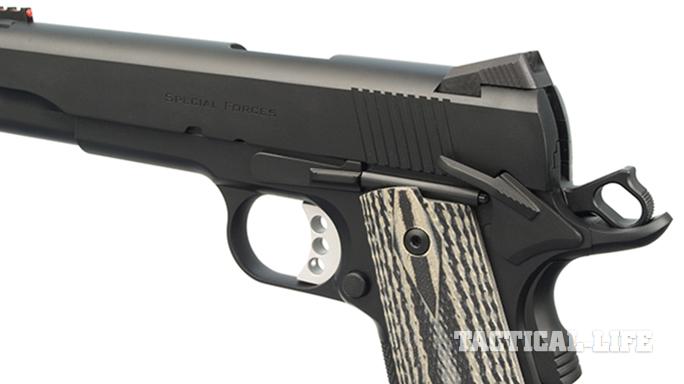
In 2010, Ed retired, turning the business over to his sons, Travis and Wade. Travis has spent 20 years in the business in sales, operations, finance and other management roles. He holds an MBA and was deeply involved in growing the business over the past 12 years. Wade has been involved with the business since 1998 and has an extensive background in engineering and gunsmithing. As Ed Brown’s chief gunsmith, he has been heavily involved in research and development. He is also responsible for overseeing all production, training and quality control.
Travis also understood that the company needed to make some changes to compete in an ever-tightening market. He wanted a person that knew the 1911 business inside and out, had a sales and marketing background, and could “hit the ground running.” As luck would have it, the ideal person with the ideal skillsets was available.
Advertisement — Continue Reading Below
- RELATED STORY: These Are the Top 5 1911 Upgrades You Should Consider Making
Travis reached out to John May, who spent over 10 years with the management team at Wilson Combat. While that company’s director of sales and marketing, Wilson’s sales grew by leaps and bounds, and the product line expanded exponentially. He also learned the 1911 business from the ground up from sourcing OEM parts to manufacturing and production. John could also bring a shooting and competition perspective to Ed Brown. He has been active in IDPA since 1999, worked closely with Joyce Wilson and Robert Ray, and served as the match director for five national IDPA championships. In short, he was the ideal person to bring a new perspective to a very successful company. It didn’t take a lot to convince John to come on board.
It was the ideal match. John was coming into a company with an established and respected brand and a loyal customer base. He found a production process that “was as streamlined and efficient as he had ever seen.” Travis tasked John with three objectives: increasing the public profile of the company through a comprehensive marketing campaign; refreshing some older models and assisting in developing new pistols and parts; and growing the dealer support network, something that John is an expert in doing.
I’ve had the privilege of knowing John May for over 10 years, and I worked with him on several projects while he was with Wilson Combat. So it came as no surprise that, shortly after starting with Brown, I received a call asking if I would like to review one of the company’s pistols. I had to confess that I had never owned or even shot an Ed Brown pistol. My impression was that the company built solid 1911s but had never stopped and given them a really good look. The current line of pistols includes 17 models that are split between Government and compact configurations.
Advertisement — Continue Reading Below
Ed Brown Special Forces
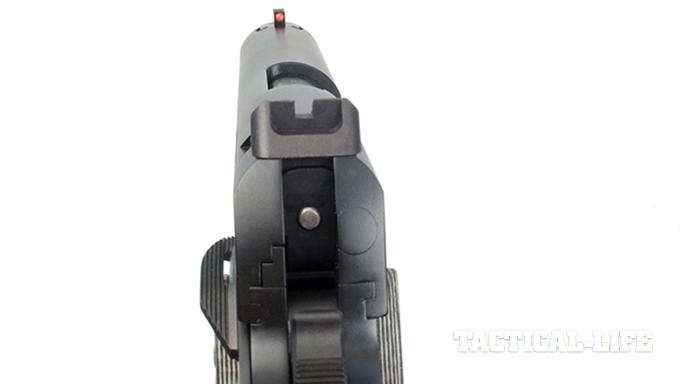
The Ed Brown Special Forces has been at the forefront of the company’s product line for many years. I asked to test this variant because I knew that if Ed Brown’s base model was good, the rest of the line would be good, too.
Each Ed Brown pistol comes in a basic nylon pouch that is embroidered with the company logo. A bushing wrench, a small bottle of Ed Brown lubricant and a 20-page manual are included with each pistol. The Special Forces model I received was a standard 5-inch-barreled .45 ACP. The slide features a Novak-style rear sight with side serrations and is paired with a red fiber-optic front sight. The slide also features slanted rear cocking serrations and a lowered and flared ejection port.
The match-grade, 5-inch barrel is precisely fitted to a match-grade bushing. Upon close examination, I noted that the prongs of the bushing had been beveled, removing any sharp edges. The outer edges of the muzzle have been rounded, and the crown is slightly recessed to provide protection during hard duty use.
Advertisement — Continue Reading Below
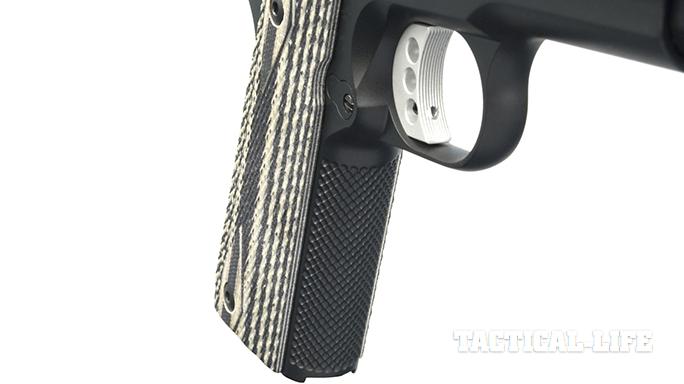
The frame of the Ed Brown Special Forces featured a nicely fitted and evenly contoured beavertail with a speed bump and Brown’s legendary “memory groove.” The extended, single-sided thumb safety is serrated and contoured to lay parallel to the slide when in the “off” position. The ledge-style slide stop is serrated to match the thumb safety. This is a nice touch that is often overlooked by other companies. The three-hole match trigger has an adjustable overtravel stop.
The frontstrap and mainspring housing feature Ed Brown’s signature Chainlink III texturing, which consists of offset rows of small round dimples that are machined in a 21-lpi pattern. Inside the magazine well, the edges of the frame and mainspring housing have been nicely beveled. Another nice touch is the finely checkered magazine release button.
The gray G10 grip panels are made by VZ with a snakeskin pattern. Finally, Each Ed Brown pistol comes with two 7-round OEM magazines with large bumper pads.
Advertisement — Continue Reading Below
Now for the finish. Over the years, I have owned and have evaluated a lot of 1911s. Each has had its own personality that reflects the manufacturer. In some ways, the Ed Brown Special Forces model is a throwback to earlier days when things were a lot simpler. To borrow an appropriate (and often overused) phrase, it has all you need and nothing you don’t. This pistol is designed from the outset to be a hard-use duty gun—not a safe queen. This carries over to the exterior finish. Ed Brown’s Gen4 coating is the company’s fourth advance in “thermoset polymer coatings,” and it provides exceptional corrosion protection and wear resistance. This finish is available in black, Stealth Gray and Battle Bronze. My test gun was black.
Brown’s Best
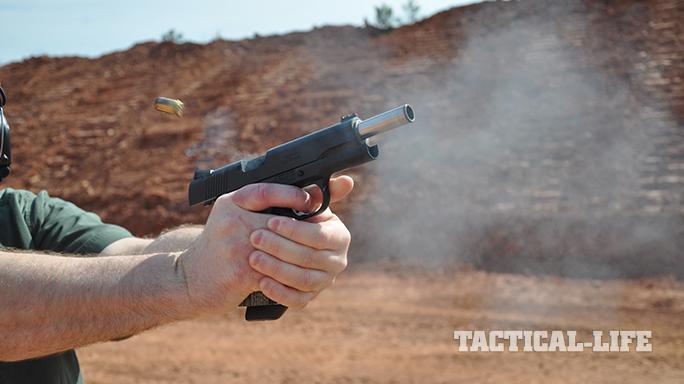
On the range, the Ed Brown Special Forces .45 was a nice return to a basic, reliable, working gun. The Chainlink III texturing provided a nice gripping surface without being overly aggressive. This texturing is also more resistant to dings than traditional checkering.
The trigger on my test gun broke cleanly at 4.25 pounds. I ran a box of 230-grain Federal American Eagle Syntech range ammo through the gun to get back in the swing of things. This is a great training load that offers significant advantages over traditional lead-core, copper-jacketed rounds.
Advertisement — Continue Reading Below
I then selected three premium duty/personal-defense loads from Federal, Gorilla Ammunition and Super Vel. These loads averaged 881, 793 and 1,188 fps out of the Special Forces’ 5-inch barrel, respectively.
- RELATED STORY: 13 .45 ACP Pistols Ready to Protect and Serve
I hate attempting to shoot groups with a pistol that is far more capable than I am. I also find that I have more difficulty shooting groups with a fiber-optic front sight than a traditional white-dot/tritium sight. That said, with considerable effort, I managed to produce 25-yard groups with each load that were all tighter than 2 inches. I then shot a modified Hackathorn “10-10-10” drill, which requires shooting 10 shots from 10 yards in 10 seconds. Shot on an NRA bullseye target, this is a true test of the shooter’s trigger control and mental discipline. I modified the drill to fire seven shots in seven seconds and managed a score of 85. Not my best day, but sometimes that is just the way it is.
In the end, I came away with an appreciation for the legacy of Ed Brown and the company’s commitment to producing a quality 1911. The only changes I would make for my personal carry would be to replace the fiber-optic front sight with a tritium/white-ring blade and remove the large bumper pads. Since the base Special Forces model does not include a magazine funnel, this would reduce the pistol’s height and profile.
Advertisement — Continue Reading Below
Leading The Way
The Ed Brown Special Forces series also includes a model with a light rail, a 4.25-inch Commander with a Bobtail, and a suppressor-ready configuration. The latter features a threaded barrel, a light rail, high-profile Trijicon suppressor sights, a magazine funnel and a Trijicon RMR. It is perhaps the ideal CQB pistol.
For those taking another look at Ed Brown, or perhaps a first look, you should know that the company only uses fully machined parts. Ed Brown will never use a cast or MIM part in any of its pistols. Ed Brown was also the first 1911 company to offer a written lifetime warranty, something that continues to this day. The company stands fully behind every pistol it makes, and it’s dedicated to the highest standards and quality.
Advertisement — Continue Reading Below
Moving forward, customers can look for a revitalized product line that will retain the heritage that has made Ed Brown a leader for over 50 years. Rest assured that the Special Forces model, and other mainstays, will remain in the lineup. In addition, there are currently some new and innovative projects in the works. At Ed Brown, there is an excitement about the future. I look forward to following these new projects and continuing my relationship with such a legendary company.
Caliber .45 ACP
Barrel 5 inches
OA Length 8.7 inches
Weight 40.32 ounces (empty)
Grips G10
Sights Fiber-optic front, fixed rear
Action SA
Finish Matte black
Capacity 7+1
MSRP $2,695
For more information, visit edbrown.com.
